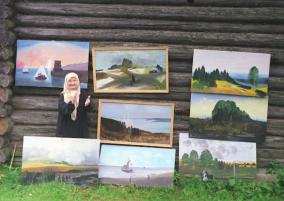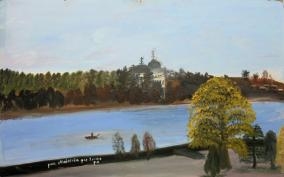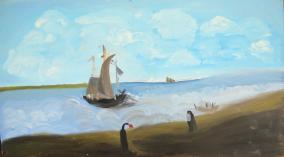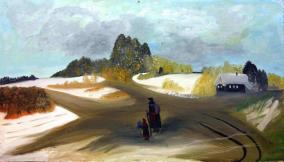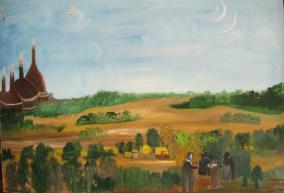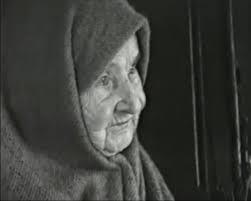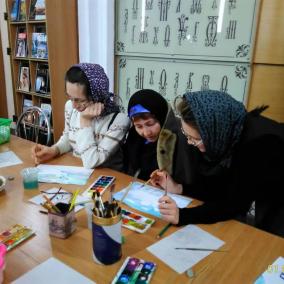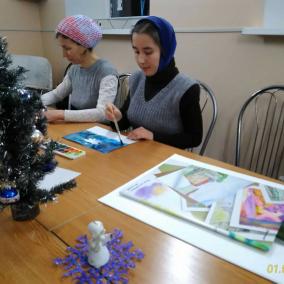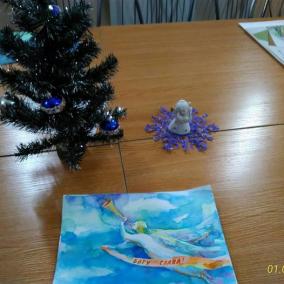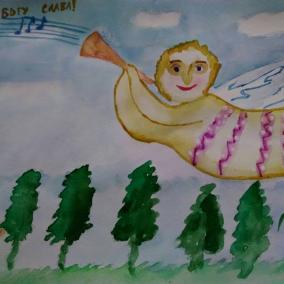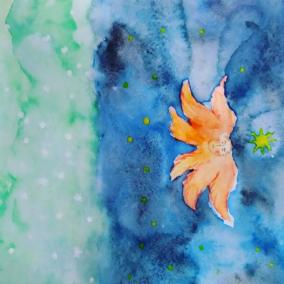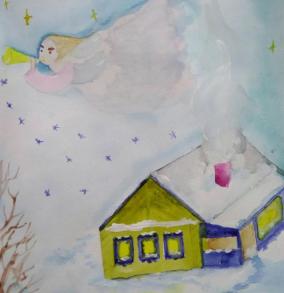Occupation in the art studio in the pre-Christmas days dedicated to naive art. The designer of the Chuvash National Museum, Nadezhda Yardykova, introduced the works of the most famous artists in the style of "naive art" - A. Russo, L. Viven, K. Bombua, I. Generalich, N. Pirosmani. A brightly representative naive in Russia was the artist-peasant Lyubov Maykova.
In each country such artists are called in different ways: amateurs, Sunday, amateurs, self-taught, artists of the Sacred Heart, insight (Latin insitus - natural, sincere), etc.
Naive art is an independent style, finally formed in the XX century. Like any art, it does not have clear dividing lines, but it is singled out: the sincerity of transmitted feelings (in our opinion, the main property); Bright coloring; Narrative of the image; Inimitability, stylistic independence; A cautious, simplistic approach with an exaggerated attention to minor details; A literal description of imaginary scenes, objects, etc.
Unlike folk art, which develops on collective, generations-old sources, or "scientist", often bearing the tradition of creative schools and unions, it is based solely on individual principles. The personality of the artist, his originality and giftedness acquire a decisive importance. Every truly naive painter has his vision and understanding of the world, which is uniquely different from the others and is a reflection of the state of his soul. As a rule, these are people with sincere, that is, natural (natural) thinking, not aware of their place in art. They stand out among other amateur artists seeking to master professional skills, and achieve an aesthetic result by their own means. From the unexpected side and out of the box. Therefore naive art can not be taught, and every attempt to imitate will be a forgery. Also it is necessary to distinguish a naive artist from an untalented person, whose hand unfairly stretches to the brush and paints.
Naive art is for oneself. The artist does not care about the attitude of the audience to his work; They only matter to him. To be "good", do not like other people or please the tastes of consumers. He does not set himself any "extra-artistic" tasks, including - commercial success.
The further fate of the works is uninteresting to him. Often, abused and ridiculed by his relatives, he continues to work, guessing that after his death, his creation awaits a "classic" fate, a garbage dump. Unfortunately, most of the work is lost.
All accepted rules of painting are broken in a naive genre. Artists are completely not interested in the problems of space, composition, professionalism, the deep meaning of the world order. A letter for them is something like playing with dolls or other toys. With a genuine imagination they play with colors, form and color, depicting not what they see, but what they know about the subject or event. Memories, dreams are often for them a material of creativity, and, having freed themselves from their labors, most often in adulthood, they present honestly, sincerely and freshly. Their paintings are like an old fairy tale. We need only admire them.
A vivid representative of the naive in Russia was the artist-peasant Lyubov Maykova (Baba Luba). Wrote about 400 paintings. Her name became known in 1986-1987 and is included in the world catalogs of naive art. About her several documentaries have been shot. Works are kept in collections of museums and private collections. Http://magazines.russ.ru/neva/2006/1/gr31.html
Artist-peasant Lyubov MaikovaWas born in 1899 in the village of Bryukhanovo Rzhev district of Tver province. After a year of studying in a parochial school for peasant children, she dropped out of school to help her parents in the farm. Since 1942 she lived in Selishche Kimrsky district of the Tver region. Worked as a cleaner, courier, postman.The first painting was written by gouache at 79 years (1978), she mastered the technique of oil painting herself (1984). In 1984, it was actually opened by the collector Vladimir Moroz, who brought canvases from Moscow from Moscow and subsequently organized the first exhibitions]. Finished drawing Baba Luba in 1993. By 1998, more than a dozen solo exhibitions were held in the largest cities of Russia, as well as in the countries of the near and far abroad. Her paintings are presented in state museums and private collections, her name is included in the international catalogs of naive art. Exhibitions• Personal exhibitions in Moscow (1986, 1987), St. Petersburg (2004), Tver (1987), Ostashkov (1988) and other cities. Region.• World Festival of Naïve Art (1989, Paris).• International exhibition "Naive artists of the world" (1990, Moscow).• Triennial of naive art (1994, Bratislava).• "Naive Art of the Center of Russia" (1997, Ivanovo).• "Artists who naively saw the life around them." (2012, Museum of Organic Culture).
Lyubov Mikhailovna Maikova died on March 23, 1998, at the age of 99, in a boarding house for the elderly and disabled in the city of Kimry. She was buried in the village of Selishche. The video "The last year of the life of a naive artist" made a great impression on the audience. Https://www.youtube.com/watch?v=7gmJLWUyhr8
In conclusion, all comers were invited to try their hand at naive art: draw a Christmas card with an angel. Https://www.google.com/url?sa=t&rct=j&q=&esrc=s&source=web&cd=1&cad=rja&uact=8&ved=0ahUKEwj8g8LcmKnRAhVBCywKHUuzDUQQFggaMAA&url=https%3A%2F%2Fru.wikipedia.org%2Fwiki%2F%25D0% 259% 25D0% 25B0% 25D0% 25B0% 25B0% 25D0% 25B0% 25B0% 25B0% 25B0% 25B0% 25B0% 25B0% 25B0% 25B0% 25D0% 25B0% 25B0% 25B0% 25D0% 258C_% 25D0% 259C% 25D0% 25B8% 25D1% 2585% 25D0% 25B0% 25D0% 25B9% 25D0% 25BB% 25D0% 25BE% 25D0% 25B2% 25B0 & 25GD% 25D0% 25B0 & usg = AFQjCNHazyupw45WOo_b5GAk-BpZqjvcrg
Photos of the works of Lyubov Maykova: http://ngribov.blogspot.ru/2010/01/blog-post.html
Виртуальный_филиал_Русского_музея при храме Новомучеников и исповедников Российских г. Чебоксары.
tags cloud
- #opening_of_a_branch
- #lecture
- #exhibition
- #virtual_exhibition
- #virtual_tour
- #online_exhibition
- #мультимедийная_выставка
- #poster_exhibition
- #online_event
- #masterclass
- #contest
- #занятие
- #festival
- #video_conference
- #round_table
- #conference
- #seminar
- #дошкольники
- #школьники
- #студенты
- #семья
- #серебряный_возраст
- #инклюзия
- #multimedia
- #Business_meeting_of_virtual_brances
- #The_Multimedia_Centre
- #Drammatika
- #деньмузеевВФРМ
- #ночьмузеевВФРМ
- #RussianMuseum130
- #RussianMuseum125
- #RussianMuseum120
- #RMcatalogues
- #Библионочь
- #книгиГРМ2019
- #игрыРМ
- #фильмыРМ
- #ночьискусствВФРМ
- #Artefact
- #100years_restorationRM
- #Peter_I_350
- #Antarctica200
- #folk_art
- #profession_restorer
- #RM_anniversary
- #SPb_anniversary
- #80летПобеды
